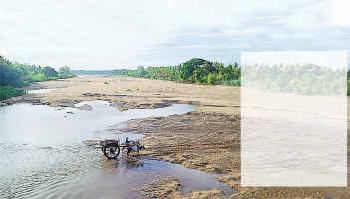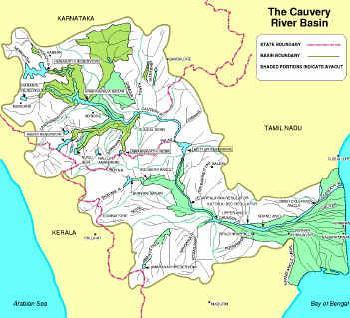
THE Water Emergency prevailing in the country both due to drought and the unsustainable, and inefficient, use of most water resources, particularly of ground water, has brought home the urgent need for launching a Jal Swaraj movement based on the conservation of every drop of water and its sustainable, and equitable, use for domestic, agricultural and industrial purposes. This was the vision of the late Anil Agarwal, founder of the Centre for Science and Environment, New Delhi, while coining the term "Jal Swaraj". In 1980, when I was in charge of Agriculture, Rural Development, Irrigation and Science and Technology in the Union Planning Commission, a five-point strategy was included in the VI Plan (1980-85) for developing a sustainable water security system for the country.
All the above water sources need to be used in a conjunctive manner. Also, in the case of dry farming areas, community conservation of rainwater will happen only if there is equity in water sharing. For this purpose, all farm families should agree to grow only low water requiring but high value crops like pulses and oilseeds. Such a method of water conservation-cum-improved livelihood security can be achieved through the organisation of Pulses and Oilseeds Villages.
In addition to these measures, steps were proposed in the VI Plan for developing a long term plan for linking the major rivers of peninsular India, like the Krishna, the Godavari, the Mahanadi and the Cauvery, as well as for the desalination of sea water. Peninsular rivers are under our political control, unlike the Ganges, the Indus and the Brahmaputra which have international dimensions.
The suggestion for linking our major rivers is not new. Dr. K.L. Rao is famous for his advocacy of the Ganga-Cauvery tie-up. Various experts have also been writing books and papers from time to time urging steps for linking our major rivers. During the tenure of Bharat Ratna Morarji Desai as Prime Minister (1977-79), the proposal of Mr. Dastur for constructing "garland canals" in the Himalayas, central and peninsular India attracted his serious attention. He however abandoned the idea when it was pointed out that constructing a canal at a high altitude in the Himalayas was beset with serious ecological, political and national security issues.
The revised National Water Policy (April 2002) of the Government of India contains the following statement:
"Non-conventional methods for utilisation of water such as through inter-basin transfers, artificial recharge of ground water and desalination of brackish or sea water, as well as traditional water conservation practices like rainwater harvesting, including roof-top rainwater harvesting, need to be practised to further increase the utilisable water resources. Water should be made available to water short areas by transfer from other areas including transfers from one river basin to another, based on a national prospective, after taking into account the requirements of the areas/basins."
Thus, inter-basin sharing of waters is an idea whose time has come. The present time is particularly a propitious one, since there is scope now for launching a massive Food and Cloth for Jal Swaraj programme, organised on the model of the Employment Guarantee Scheme of Maharashtra.

Based on the financial provision made in the VI Plan for initiating steps for linking the rivers of peninsular India, the Central Water Commission had undertaken detailed studies. Given the necessary political will and consensus, the linking of the rivers of Peninsular India and the equitable and efficient use of this gigantic water grid will help to create a "win-win" situation for all the States involved. If there are winners and losers, there will be only conflict and confrontation, as is happening now.
It is time we move in the direction of rainwater harvesting, watershed development and the conjunctive use of rain, river, ground, treated sewage and sea water on the one hand, and river water linking on the other. China, which has taken a long-term view in the area of building a national water security system, has already made much progress in building the gigantic Three Gorges Dam, for taking the waters of the Yangtzi river to the parched lands of the northern parts of that country. The Three Gorges Dam will confer multiple benefits in the areas of flood control, irrigation, drinking water supply and power generation.
Our country, unfortunately, is one where there is often paralysis by analysis, particularly in vital areas like inter-basin sharing of water. For example, a National Water Policy was adopted in September 1987. It remained largely on paper. This policy was reviewed and updated in April 2002. However, implementation structures for converting the policy into reality do not exist. There has been no effort to mobilise the Panchayat Raj institutions for harvesting and sharing water at the local level. The Centre for Science and Environment and the Akash Ganga Trust have established in Chennai a Rain Centre, which is a single stop information centre on all aspects of rainwater harvesting, storage and use. We need such rain centres in every village and town in the country. In each Panchayat and Nagarpalika, at least two women and two elected members should be trained as Water Security Managers, capable of looking at water security issues in their totality, namely and consumption of water to meet the needs of human settlements, agriculture, industry and ecosystem maintenance.
While there is discussion and debate relating to the quantitative aspects of water needs, the same interest is not evident with reference to the qualitative aspects of water, with particular reference to domestic consumption. For example, the C.P.R. Environment Education Centre in Chennai has observed the following position in relation to ground water quality in the Chennai area.
Water samples from 25 different locations in Chennai, collected from wells and bore wells were analysed for their potability in the Centre's laboratory. The pH of the samples ranged from 6.50 to 8.81. The Total Dissolved Solids (TDS) exceeded 500 mg/l (the desired limit of TDS in drinking water) in 88 per cent of the samples, and 64 per cent of the samples contained more than 1000 mg/l of TDS. Twenty-eight per cent of the samples contained more than 2000 mg/l of TDS, the maximum permissible limit as per IS 10500:1991. Twenty-four per cent of the samples had a high level of iron content. This clearly indicates the sad state of ground water quality in Chennai.
The Ganga Action Plan, after huge investment and many years of work, could not succeed in making the water of this "holy" river potable. This is attributed to non-point pollution, caused by human beings, many of them being pilgrims. The same fate is true of most of the rivers and tanks revered for their spiritual significance. It is clear that unless water becomes everybody's business, as Anil Agarwal put it, it will remain a source of conflict and contamination.
India has enough water resources to fulfil everybody's needs. We live in a democracy. Let us designate 2003 as a Water Emergency Year and initiate during the year a Water Literacy Movement which will stimulate State and Central Governments to launch an integrated water security strategy with the following short and medium term action plans. In the short term, emphasis may be given to the following:
All the above steps are politically doable and economically affordable. The short-term steps mostly need non-monetary inputs, since they depend upon people's awareness and participation on account of enlightened self-interest.
In the medium term, we should initiate action to use conjunctively sea and ground water along the nearly 8,000 km shore line of India for raising plantations of mangroves, salicornia, casuarina, cashewnut and coconut. Also, agro-aqua farms can be established all along the coast for promoting integrated systems of aquaculture and agro-forestry.
Above all, we should not lose even a day more in fostering political consensus to link all peninsular Indian rivers in the form of a Dakshin Water Grid. When coupled with the Prime Minister's National Highways project, the Dakshin Water Grid will usher in uncommon opportunities for strengthening both food and livelihood security, leading to a hunger and poverty free Dakshin.
Jal Swaraj will become a reality only if such a movement is built on the foundation of the twin pillars of equity and ethics. For this purpose, all political parties must agree to abide by the rule of law and respect the findings of institutional structures set up to settle disputes relating to sharing of water, particularly under conditions of scarcity. When Lal Bahadur Shastri coined the slogan "Jai Jawan, Jai Kisan", he wanted us to respect contributions of every Indian Jawan and Kisan to national security. Since about 75 per cent of our water resources go to agriculture, sharing the joys and sorrows of all Indian farmers in an equitable manner is vital for both agrarian prosperity and sustainable food security.
In these days of "water peril", we should follow the advice given in 1955 by Bertrand Russell and Albert Einstein when the world was confronted with a grave nuclear peril. "There lies before us, if we choose, continual progress in happiness, knowledge and wisdom. Shall we, instead, choose death, because we cannot forget our quarrels? We appeal, as human beings, to human beings; Remember your humanity, and forget the rest. If you can do so, the way lies open to a new Paradise; if you cannot, there lies before you the risk of universal death".
The writer is the chairman of the M.S. Swaminathan Research Foundation. He has worked for the past 45 years with scientists and policy makers on a wide range of problems in basic and applied plant genetics as well as in agricultural research and development.




|

|

|